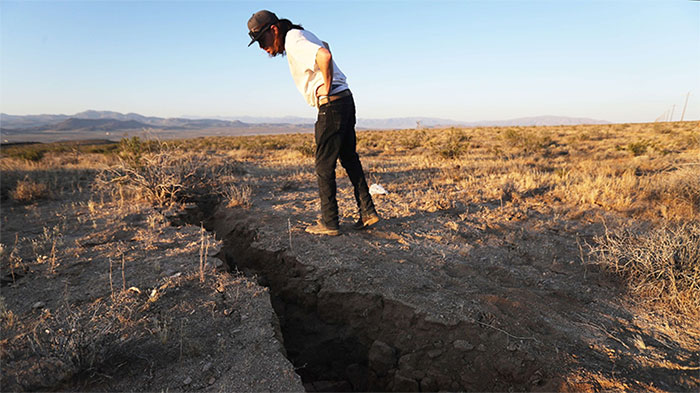California earthquake signs San Andreas seismic once every 150 years?
For many years, US geologists have warned of the possibility of a huge earthquake along the San Andreas fault that cuts through California (USA) because its 150-year cycle has expired.
Shortly after the 6.4-magnitude earthquake shook southern California on July 4, filmmaker Ava DuVernay, a Los Angeles resident, described on Twitter that it was the longest shock she had ever experienced.

People checked a crack after an earthquake of 6.4 degrees on July 4 near Ridgecrest, California - (Photo: CNN).
"I wonder for the first time if this is it - seismic San Andreas?" - Ms. DuVernay wrote. But that's not the end, just one day after California continues to shake by another earthquake of up to 7.1 degrees ritcher.
Finally, people are relieved that both are not the most frightening nightmares, but for Californians in particular and Americans in general, this event is a peaceful reminder that can end on any when.
According to the US Geological Survey (USGS), large earthquakes often occur in the southern region along the San Andreas fault every 150 years. The last time a big earthquake occurred was in 1857 (ie 162 years), so the possibility of it would repeat again in the coming years.
USGS judged that a 7.9-magnitude earthquake happened in San Francisco in 1906, so it was unlikely that it would appear in northern California.
Over the past few days, newspapers in the United States have simultaneously snatched a warning, the Los Angeles Times : "The earthquake on 4-7 will not repel San Andreas"; New York Times: "A warning that San Andreas is stalking" .
Dr Lucy Jones, a seismologist at the California Institute of Technology, said the recent earthquake did not activate San Andreas faster (the concussion location was north of the fault), but they did not reduce its ability. happening.
"Every year there is always 2% of San Andreas seismic probability occurring, or equivalent to 1 / 20,000 per day. Although the probability is not too high, residents should not be surprised. People need to be prepared for that day " - Mrs. Jones explained.
According to the USGS, a caliber of events like San Andreas will often begin with a period of increased seismic activity for several years. Over the past two decades, southern California experienced a "very quiet" period until last week.
"Next, we will have to think about this more" - Jones expert commented.
- California earthquakes create giant cracks in the desert
- 1,300km break in California can destroy 3.5 million houses
- Terrifying warnings about imminent earthquakes
- The fire belt shook, the Californians feared
- Use virtual earthquakes to predict Los Angeles scenarios
- The truth about the risk of super-earthquakes in Asia
- Strong earthquake in California
- The earthquake is 6.9 degrees off California
- California moved south
- Warning will have large earthquakes
- The strongest earthquake in 25 years in San Francisco
- Why do earthquakes in the US do not shake the streets?
- California at risk of tsunami
 Is the magnetic North Pole shift dangerous to humanity?
Is the magnetic North Pole shift dangerous to humanity? Washington legalizes the recycling of human bodies into fertilizer
Washington legalizes the recycling of human bodies into fertilizer Lightning stone - the mysterious guest
Lightning stone - the mysterious guest Stunned by the mysterious sunset, strange appearance
Stunned by the mysterious sunset, strange appearance